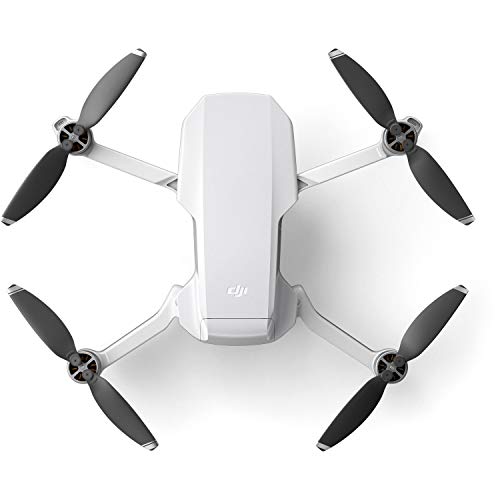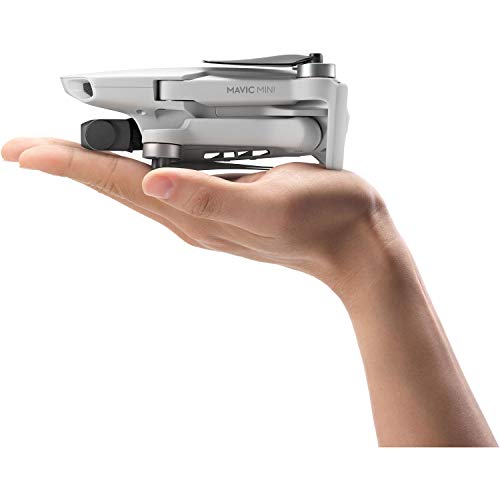Description
DJI Mavic Mini: how did it all start?
Back in 2016, aerial photography continued to turn into a new, independent form of photography. The drones were larger and heavier, which naturally created a demand for lighter mini-drones that could be easily carried around. Users dreamed of a compact portable drone that would provide excellent camera performance. We listened to the ideas and suggestions of all those dreamers, and that is how history began.
The evolution of mini-drones
Reducing the size of the drone is not an easy task, given the need to compensate for many components, which, as a rule, affects the performance of the mini-drone camera.
With lighter drones, propulsion systems have more work to do to stabilize the drone in high winds. Previous mini-drones on the market had shortened propellers, smaller frames and simple propulsion systems, which affected the flight performance in wind conditions.
In the past, to reduce the weight of drones, GPS and vision sensors were not included in the drone. The need for a light drone simply affected its flight performance. Smaller frames meant that there was also less room for batteries that couldn’t support the more advanced, powerful propulsion systems. Camera performance has also suffered, as many drones on the market support mid-range sensors and camera systems to meet weight restrictions.
What makes the DJI Mavic Mini special?
Focusing on portability, reliability and camera performance, our engineers began developing an unmanned aerial vehicle that optimized both performance and lightweight design.
The DJI Mavic Mini is the smallest and lightest drone DJI has ever made. It is also equipped with a powerful 3-axis stabilized camera, with a maximum transmission range of up to 2 km and a maximum flight time of up to 30 minutes, which is a leap in performance compared to previous mini-drones on the market.
Years of pioneering research
The DJI Mavic Mini is the result of many years of experience in the drone industry. DJI first introduced the patented folding design for the Mavic series, and this folding design has become a hallmark of modern drones. The DJI Mavic Mini is smaller than the Mavic Air, which means that even after the DJI engineers introduced the folding design, it was necessary to build a more efficient system to compensate for the smaller battery and engines. With this in mind, the engineers struggled and developed a plan to improve the ratio of traction weight, power of the airborne electronic system and propulsion system efficiency.
Speed to Weight Ratio
This describes the relationship between thrust and weight of the aircraft, which indicates the flight characteristics of the drone. The dimensionless coefficient is proportional to maximum traction and inversely proportional to weight. Therefore, to increase the wind resistance of the Mavic Mini, engineers had to either increase traction or reduce weight. The increase in traction leads to an increase in the form factor of an unmanned aerial vehicle, which has led to the need to develop innovative ways to reduce the weight of an unmanned aerial vehicle.
Battery efficiency
This performance index determines how efficient the engines and propellers of the aircraft are. Simply put, propulsion systems with higher efficiency result in lower power consumption, which increases flight time. Our engineers created a system that skillfully used as much energy as possible from the battery and engines, while at the same time focusing on the principles of high traction.
Air Electronic Power System
Excluding battery power, the antenna power of an electronic system refers to the power of the entire electronic system. System power has been optimized to provide longer flight times.
Milligram weight control
So, how exactly did DJI engineers increase traction to weight ratio and reduce drone weight?
Since development, engineers have been doing everything possible to control the weight of the drone. From the use of low-density materials to weight control to milligrams, extensive tests have been conducted to ensure optimal performance.
How easy is a milligram? Well, rice grains weigh between 5 and 10 mg, and the engineers worked diligently with these incredibly small numbers. When it comes to mass production, we have also expanded the limits of UAV production.
To put all this in context, the weight of the microSD card is about 0.25 g, and that was the level of detail that was being introduced. As part of strict weight control measures, engineers carefully inspected every part of the drone to make sure they were able to accomplish this truly innovative feat.
The smallest unmanned aerial vehicle DJI in the world
DJI Mavic Mini is the first unmanned camera created by DJI, which sets a precedent for future mini-drones.
Considering that the group of drone cooling coolers weighs about 10 g, this feature has a huge impact on the weight of the drone. The cooler-free design reduces power consumption and provides more space for a larger battery.
However, DJI engineers soon faced another problem. Are coolers necessary for heat dissipation, since they can cool the drone while reducing weight? After conducting several aerodynamic tests, the engineers redesigned the cooling system and tried to ensure efficient heat dissipation from the propellers themselves.
When the drone freezes, the inverted airflow generated by the propellers is directed to the radiator at the bottom of the drone. The inlet and outlet ducts also provide a cooling effect equivalent to that of a fan. When the drone flies forward, air will be blown into the channels behind the camera suspension and dissipate heat along with the air currents created by the propellers.
Final optimization
While we are flying through the history of the DJI Mavic Mini, at this stage, engineers optimized the ratio of traction and weight, propulsion system, electronic system and created a design without a fan. But there were still no parts in the puzzle. How can energy efficiency be improved without changing energy consumption?
The answer is pretty simple. Propellers not only dissipate heat but can also be aerodynamically optimized to increase flight efficiency. With this in mind, the screws were redesigned using smart tests and optimization algorithms. Aerodynamic engineers have carefully designed a set of optimized propellers that make the best use of engine power.
Research continued, and electrical engineers tried to achieve the maximum balance between engine power and consumption. The R&D team redesigned brushless motors, replaced the internal magnetic coil, and analyzed power consumption using our rigorous motor algorithm.
Research outside the laboratory
Data from the lab is just the beginning of the DJI Mavic Mini’s story. The team took the DJI Mavic Mini out of the lab and tested it under various operating conditions. From 3,000 meters above sea level to strong winds and freezing temperatures, the DJI Mavic Mini has been tested in many types of environments to improve flight performance and stability.
The DJI Mavic Mini is the result of many years of research, engineering knowledge and innovation. In creating the DJI Mavic Mini, DJI engineers have combined the needs of the UAV market to redefine the possibilities for modern unmanned aerial vehicles. And now, with 2.7K HD video and the ability to fly up to 30 minutes or more, the possibilities are in your hands.





